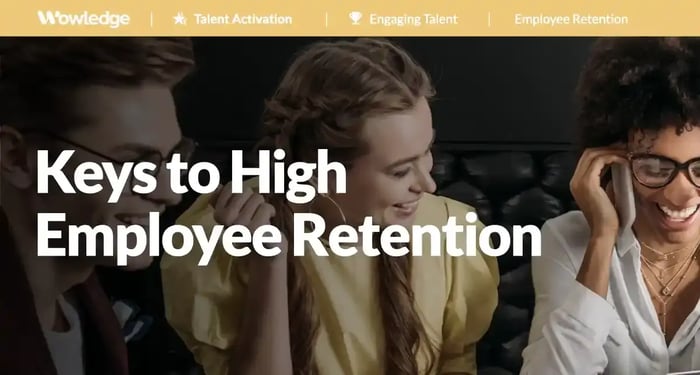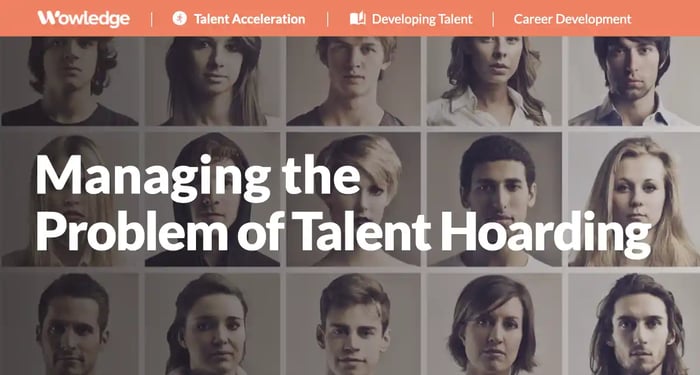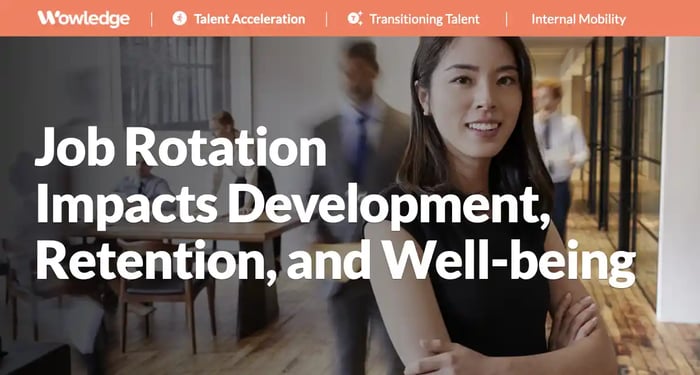Table of Contents
- Understanding the business benefits of employee retention
- Why employees leave their jobs/companies
- What are the keys to high employee retention?
- 1. Creating and maintaining a positive work culture
- 2. Continually assessing and enhancing the employee experience
- 3. Providing competitive compensation and benefits
- 4. Accentuating and encouraging career development and growth opportunities
- 5. Supporting work-life balance
- 6. Insisting on constructive leadership and effective management
- 7. Driving employee involvement and empowerment
- 8. Balancing workloads and manageable expectations
- 9. Providing meaningful recognition and rewards
- 10. Practicing transparent and effective communication
- Thoughts on new hire turnover
- Relevant Practices & Tools
- FAQs
With all the concerns over the past few years related to talent shortages and recruiting challenges that organizations of all sizes and industries are experiencing despite adjustments in force, the issue of why so many jobs need to be filled in the first place has risen to the top. It has become apparent that the counsel many of our then-peers provided decades ago to HR and line management teams was prescient—that success in recruiting often stems from strong turnover control. The less pressure Talent Acquisition teams are under to continually fill large volumes of jobs, the better they can focus on quality versus quantity of hire. Resolving this requires understanding the keys to employee retention.
In fact, employee turnover rates have sadly hit new heights, with the U.S. Bureau of Labor Statistics reporting that “the rate of job quitting in the United States has reached levels not seen since the start of the U.S. Bureau of Labor Statistics Job Openings and Labor Turnover Survey program at the beginning of this century.” As an example, in one year alone, more than 50 million U.S. workers quit their jobs.
While turnover rates have eased somewhat recently, there is plenty of research showing that the “intention to leave” rates are continuing at a high level; perhaps it’s due to lowered hiring rates in certain sectors due to the large layoffs we continue to see, which has softened the availability of jobs to go to. However, in a recent LinkedIn study, 61% of US employees were considering resigning in the short term, led by almost 70% of Gen Z and millennials who reported they planned to leave their jobs that same year.
Consistent with that data, numerous surveys by Bankrate, Joblist, and Future Forum’s Winter Pulse Survey all report findings that between 37% to 67% of workers also planned to leave their jobs within a year.
And the leverage job candidates have in the labor market remains tight. The Bureau of Labor Statistics reported that the ratio of unemployed people to job openings dropped to 0.5 - 0.6 since October 2021. That means that, on average, for every open job, there is only ½ a candidate. Think about it: talent acquisition pros will tell you they target 10 reasonably qualified applicants per job to yield 3 solid interviewees, from which 1 or 2 may be good fits and thus suitable for a job offer. The numbers are leaning heavily against the recruiters.
Going back to the point about easing recruiting challenges with quality employee retention outcomes. Retaining quality performers is a necessity these days. It is neither a luxury nor an HR objective, but a business imperative. Maintaining a strong, optimally tenured workforce is critical to sustaining organizational and operational capabilities that deliver stakeholder and consumer value. LinkedIn’s Workplace Learning Report tells us that 93% of organizations are concerned about employee retention.
Understanding the business benefits of employee retention
Employee retention offers numerous business benefits. Key advantages include:
1. Cost savings
Employee turnover can be costly for organizations (1-2X annual salary). By focusing on employee retention, businesses can reduce recruitment, onboarding, and training expenses associated with replacing and enculturating new employees. Retaining experienced staff helps minimize productivity gaps and avoids the costs associated with the risks (poor cultural fit, mismatched expectations) inherent in hiring new employees.
2. Knowledge and expertise retention
Long-term employees develop valuable institutional knowledge and expertise specific to the organization and industry segment. Retaining these employees ensures that the company can retain critical skills, knowledge, and networks related to work processes, collaborations, and best practices, leading to operational efficiency and continuity.
3. Enhanced productivity and performance
Employees who stay with an organization for a longer duration tend to become more familiar with their roles, work processes, and organizational dynamics. This familiarity leads to increased productivity and efficiency as employees can focus on delivering results rather than constantly learning and adapting to new applications of their expertise.
4. Improved customer satisfaction
Consistent interactions with knowledgeable and experienced employees can significantly impact customer satisfaction. Retaining employees who have built relationships with customers and understand their needs can lead to higher customer loyalty, repeat business, and positive word-of-mouth referrals.
5. Employer brand and reputation
A company known for its high employee retention rates and positive work culture can attract top talent and differentiate itself in the competitive job market. A strong employer brand enhances the organization's reputation and makes it an employer of choice, enabling it to attract and retain high-quality candidates.
6. Organizational stability and growth
Employee retention leads to a stable workforce, reducing disruptions caused by frequent turnover. With a consistent and committed workforce, organizations can focus on long-term goals, innovation, and growth strategies. Retaining employees who are aligned with the company's mission and values contributes to organizational stability and sustainable growth.

Why employees leave their jobs/companies
The issue of turnover has been studied for years. While there have been more recent updates to the list of common reasons (e.g., post-COVID return to the office policy changes, inflationary pressures to earn greater wages), the list of most frequently cited reasons should sound familiar to HR professionals. Those include:
- Lack of growth and development opportunities: This includes opportunities and options for education and skills development, job enrichment and expansion, internal mobility, exposure to new or emerging business initiatives and areas, and so on. Without access to these opportunities, employees come to feel stagnated and uninspired by the lack of variety and a sense of growth and change.
- Poor relationships: This can occur in the context of (oft-cited) employee-to-manager relations (feeling a lack of support, micromanagement), a sense of belonging and place within the team or broader employee population (think weak DE&I), encounters with a toxic work environment (such as hyper-competitive cultures), and so on.
- Lack of work-life balance: People working in jobs that require long hours, extensive travel, night/weekend work, call-in or stand-by scheduling, and the like can experience difficulties in simultaneously meeting their familial and personal requirements.
- Absence of or insufficient autonomy: Providing people with the ability to exercise a level of independence in deciding how their work will be conducted, what steps they will take to accomplish it, and when those will occur goes a long way to providing a sense of control over their environments and lives, key drivers of a positive human experience. And micromanagement can lead to feelings of helplessness and a sense of lost dignity.
- Low job meaningfulness: Employees who lack a sense of how their efforts align with and contribute to the organization’s mission and outcomes, much less contribute to the betterment of customers’ and societies’ outcomes find themselves less committed to and engaged with their work and the organization itself. People seek meaning in what they do to provide a sense of importance, value, and belonging.
- A lack of recognition: Without positive feedback and credit for contributions, employees feel undervalued for the hard work and sacrifices they make. A paycheck only carries people so far. Studies conducted over the years have shown that a lack of appreciation is a major contributor to employee dissatisfaction and turnover.
- Uncomfortable facilities: Consider factors around the work location (e.g., downtown, high crime areas), commuting distance/difficulties (long commutes, lack of public transportation), facility comfort levels (open layouts, windowless offices), working environment conditions (outdoors, poor weather, loud/dangerous machinery) and the like.
- Poor corporate results and image: People want to be proud of the organizations for which they work, and when one is struggling (revenue growth, profitability, market share, share price) the impact on employees can be immense. It can also lead to restrictions and cuts in budgets, rewards and recognition, as well as tightened managerial controls, all of which directly impact the employees’ sense of security and well-being.

What are the keys to high employee retention?
As high employee retention is essential for the stability and success of any organization, companies typically have strategies in place to address the desire to enhance the desire of employees to remain in their employment. Addressing the aforementioned causes of employee turnover are core to the creation of a positive and engaging employee experience. Beyond that, larger-scale opportunities exist to address the needs and preferences of employees. Keys to employee retention include:
1. Creating and maintaining a positive work culture
A positive work environment that promotes teamwork, respect, and open communication plays a crucial role in employee retention. Encouraging collaboration, recognizing and rewarding employee contributions, and fostering a sense of belonging are critical. Monitoring the work environment, down to the individual department, is a crucial step here—the need for multiple and continuing culture measurement and employee listening vehicles to assess and address any weak spots or inconsistencies with stated corporate values cannot be overstated.
2. Continually assessing and enhancing the employee experience
Creating formal programming to understand what is most important to employees as they interact with administrative and work processes, technologies, management, teams, and peers alike is key. This calls for disciplined approaches to evaluating the employment lifecycle, from candidate sourcing to retirement, from applicant to alumni status. Developing an appreciation for how the employee experiences working and participating in the organization is essential to creating an outstanding employee value proposition (EVP) that is living and breathing. As this involves asking the employees how well the systems, policies and processes work for them, both the communications and improvements act as statements of how much the organization values their input and continuing employment.
3. Providing competitive compensation and benefits
Offering competitive salaries, incentives, and comprehensive benefits packages helps attract and retain talented employees. Regularly reviewing compensation structures and ensuring that they align with industry standards can contribute to employee satisfaction and loyalty. Considering both the market value of their services (including decisions relative to new hire salary levels) and their associated purchasing power relative to economic conditions are critical pieces of the retention puzzle.
4. Accentuating and encouraging career development and growth opportunities
Employees seek growth and advancement in their careers. Providing opportunities for learning, training, and professional development not only enhances their skills but also shows a commitment to their long-term success. Focus special attention on informal development opportunities that blend learning with career development, such as regular project team participation, coaching and mentoring programs, stretch assignments, job shadowing/temporary cross-departmental or functional assignments, and community leadership contributions. Doing this at scale can help build a culture of development and reputation for individual growth, both of which can be keys to great retention levels.
5. Supporting work-life balance
Balancing work and personal life is a priority for employees. Offering flexible work arrangements, such as remote work options or flexible scheduling, can improve work-life balance and contribute to higher employee satisfaction and retention. Review and enhance policies that provide freedom and support to handle familial or personal (e.g., physical and mental health) issues and educate managers on their fair and equitable use and administration. And remember to monitor managerial behavior and decisions for compliance with available policy, program, and practice (e.g., job-sharing, leaves of absence) options.
6. Insisting on constructive leadership and effective management
Supportive and effective managers who provide clear direction, mentorship, and regular feedback are crucial. Employees are more likely to stay in an organization where they feel valued, respected, and have opportunities for growth. To that end, review and upgrade managerial job selection criteria and processes to ensure that managers have core skills and capabilities consistent with positive and constructive managerial behavior standards. Create systemic (and anonymous) employee surveys and ratings of managerial effectiveness and behaviors to track and better create a consistent employee supervision experience.
7. Driving employee involvement and empowerment
Encouraging employee involvement in decision-making processes, providing autonomy and ownership over their work, and seeking their input on important matters can foster a sense of empowerment and engagement, contributing to higher retention rates. Consider reviewing and upgrading job designs to enhance and encourage employees’ ability to exercise discretion at all levels of the organization. Consider the value of self-directed work teams in more routinized jobs and functions. Reward managers who regularly gather and use team input on important workflow, process, and improvement ideas.
8. Balancing workloads and manageable expectations
Given recent layoffs, monitoring and ensuring that employees' workloads are reasonable and achievable helps prevent burnout and enhances job satisfaction. Setting clear expectations, providing resources, and addressing work-related challenges in a supportive manner are vital for retention. By collecting and analyzing productivity, payroll data, and related metrics, plus employee listening strategies, data can be leveraged to keep track of any departments, locations or functions where overwork is occurring.
9. Providing meaningful recognition and rewards
Acknowledging and appreciating employee achievements and milestones through various recognition programs, performance-based rewards, and promotions can boost morale and increase loyalty. Consider the value of adding peer-driven recognition processes that give employees a voice in expressing gratitude and support for extraordinary efforts and contributions by their co-workers to build teamwork and camaraderie. Such recognition should be captured and included in annual performance evaluations.
10. Practicing transparent and effective communication
Transparent communication channels, both upward and downward, promote trust, reduce uncertainty, and foster a positive work environment. Regularly sharing information about organizational goals, changes, and challenges helps employees feel connected, engaged, and trusted. Regular employee gatherings/all-hands meetings, skip-level sessions, executive video chats and messaging, and similar events should be leveraged as a way to keep employees at all levels apprised of company strategies, progress towards key objectives, and results.

Thoughts on new hire turnover
The costliest and often most painful turnover is arguably the new hire departure that occurs in the first 30-90 days, but for many companies extends into the end of the first year. It is during that timeframe that the new hire is learning the processes, identifying resources, developing a network, and coming up to full productivity. The pain is experienced because the return on investment (costs related to recruiting, onboarding, training and lower productivity) has not yet been achieved.
It is caused by numerous reasons, including:
- Rushed hiring process – one that failed to fully vet the new hire’s background, capabilities, and fit.
- Lack of realistic job preview – overhyping of the work, levels of contribution, status in the company, etc., or not fully explaining job duties, requirements, expectations, and working conditions upfront.
- Cultural mismatch – all too often recruiters and managers focus on the candidate’s background, experiences and skill sets without paying sufficient attention to the fit with corporate culture, values, and behavioral/outlook expectations.
- Dissatisfaction with manager or peers – early issues with the style and substance of guidance received from the hiring manager or poor relationships with peers can trigger concerns of a lack of fit within a team.
- Departure of a hiring manager or referring colleague – the turnover of a manager or respected colleague(s) with whom they had bonded can often lead to questioning the projected fit and opportunities to excel that the new hire held upon accepting the job. The resulting loss of desire to work in the changed environment can lead to an updated job search.
- A better opportunity presents itself – as recruitment processes vary in length, a job offer from a competitor may have been late in the offing, and once it is presented becomes too tempting to turn down.
Anticipating these situations is imperative for both HR and new hires’ managers, especially during those early months. Systemic solutions should be installed to monitor risk of loss, and ensure that each new hire is appropriately welcomed, enculturated, developed, and guided to full productivity and fit within the company. Keys to employee retention for new hires call for steps such as these:
1. Leverage a robust onboarding process
A formal onboarding process should include complete resourcing on Day One. The need to have everything ready and waiting for the employee on their first day communicates a readiness to accept them into the fold and make them feel like a fully outfitted member of the team. These should include an employee badge and facility accesses, parking passes, workstation/cubical/office, laptop/computer, and systems accesses/passwords, among others. Furthermore, assign a tenured peer (or co-worker group) to answer questions and guide them through the facilities, administrative processes, resources, and so on. Welcoming lunches and introductions to/meetings with key personnel, customers, and vendors they will need to build relationships with are often helpful and appreciated by new hires.
2. Enculturate the new hire
Sessions for new hires often include an overview of the company values, strategies, and key initiatives, with a focus on corporate history and achievements, key decision makers, contributions to the industry and society/community, and opportunities for new hires to get engaged with any of these. Introductions to any new hire clubs or cohorts, employee resource groups (ERGs), social activities (basketball or softball league, wine club), and the like can offer opportunities for new hires to “find their tribe” within the larger corporate structure and outside of their normal functional teams.
3. Plan development
Managers should hold initial meetings to discuss a first-year development plan that blends any skill gaps identified in the recruitment process with individually desired skill or capability growth. Access to, and suggestions for training or certification programs, introductions to experts for mentoring, assignments to special projects, etc. can provide a structured development path that a new hire often needs. Longer-term career discussions should also fit into the conversations, as employees want to see a future of growth and opportunity.
4. Listen and pulse
All new hires should be proactively offered opportunities to provide feedback to identify any breakdowns in onboarding and first-year experiences. Brief, pulse surveys asking about the elements that the company has learned are “moments that matter” from employee experience analyses should be sent out at 30, 60, 90, 180 and 365 days to monitor and track new hire satisfaction with, and access to/completion of certain steps in the process. Typical “moments” include introductions to key people, awareness of corporate /departmental goals, availability of desired development programs, coaching from one’s manager, and success in building social networks.
5. Develop predictive measures
Creating turnover predictors is an excellent strategy for assessing risk. While it involves advanced analytics and statistics, it can be accomplished by surveying only a couple of hundred current and former employees. Departed employees are usually (and often surprisingly) willing to complete an anonymous survey about their experience and reasons that contributed to leaving within the first 3-12 months after quitting. In the most basic analytic scenario, comparing their responses to quality of employment questions to current employees (in similar jobs, roles, and levels) and applying predictive (e.g., statistical regression) techniques can yield a brief set of predictive survey questions. Such questions can be subsequently sent to current employees to assess the likelihood of their leaving. Action steps can then be taken to better understand their feelings and make changes to avoid their loss.
Structured and disciplined approaches to new hire onboarding are critical elements of maximizing the return on investment from the hiring process, and more importantly, are key to building a culture of awareness, inclusivity, and development. Such programming supports the longer-term goals and keys to employee retention by establishing a baseline of activities that are consistent with robust talent management practices that contribute to corporate success.
Relevant Practices & Tools
Core Career Development Practices that Translate Employee Ambitions into Occupational Progression Action Plans. >
Core Career Development is a process through which employee development is guided towards a targeted series of successive job roles that build upon one another... more »
Constructing Career Paths to Identify Future Aspirational Roles. >
A career path (or “ladder”) is a logical progression of increasingly challenging jobs within a specified function that primarily includes vertical movement throughout an organization... more »
Creating a Culture of Internal Mobility that Supports Employee Development and Retention. >
Creating a culture of mobility requires management to accept that the benefits of movement (promotions and transfers) far outweigh the costs of replacing workers in their teams... more »
Creating a Learning Culture that Supports Career-long Education and Development. >
A learning culture is one that encourages and supports employees’ continuous pursuit of knowledge, sharing of learning with others, and motivation to continuously upgrade... more »
The Individual Development Plan (IDP) Tool: Capture Targeted Employee Learning and Development Actions for a Performance Period. >
A plan of action to guide the employee throughout the coming performance period (e.g., year) as they continue to develop necessary knowledge, skills, abilities, and competencies... more »
FAQs
Which retention metrics give the clearest signal, and how often should they be reviewed?
The most useful set of measures tracks monthly voluntary turnover, regretted loss rate (e.g., high performer, critical role), first-year attrition, internal fill rate, and time since last career move. Breaking each by manager, team, role, location, and demographic segment exposes hot spots early. Quarterly deep dives help shape action, while a short monthly pulse keeps leaders honest on trends. Consistent definitions and a single source of truth prevent debate from replacing action.
How should retention tactics differ by employee segment?
All employees should have development plans and associated progress check-ins 2-3 times per year. Career discussions should always include aspirations, with work assignments and coaching adjusted accordingly. Critical roles need risk mapping, succession depth assessments, and proactive career moves every 18–24 months, depending upon readiness and personal aspirations. High performers benefit from visible sponsors and mentors, stretch assignments, and clear paths to higher-impact contributions (lateral or vertical). New hires need milestone-based onboarding and quick wins within 60 days, with development paths to which they and their managers are held accountable. Hard-to-hire skills often require market-value checks and targeted recognition to reinforce a sense of belonging and purpose.
How can flight risk be spotted without a complex analytics build?
Simple indicators work when viewed together, such as stalled pay or progression, declining learning activity, rising unused PTO, and drops in one-on-one completion with their managers. Sudden changes in calendar patterns, with fewer team meetings attended or more short “private” calendar blocks, often precede external interviewing and exits. Managers who log coaching notes and goal progress create a practical signal that can be monitored in weekly business reviews. The aim is not to label individuals, but rather to prompt timely conversations about an individual’s intent to leave, and what should be done to re-engage them.
Which manager behaviors most influence retention, and how can they be enforced?
Meaningful and more challenging work, reliable one-on-ones, clear goals, timely feedback, and visible advocacy for employee development are the behaviors most linked to staying. These can be tracked with simple task completion data, survey items on coaching quality, and evidence of moves or project placements. Tying a portion of manager bonuses to regretted loss and internal moves by diverse talent drives attention. Public recognition of “talent exporters” reinforces the culture.










